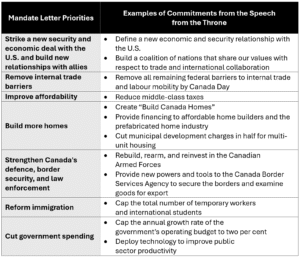King Charles III Delivers Speech from the Throne
In his first visit to Canada as the Sovereign, His Majesty King Charles III delivered the Speech from the Throne to open the first session of the 45th Parliament. The speech was a continuation of the “nation-building” theme we have heard from Prime Minister Mark Carney since the Liberals were re-elected, echoing Carney’s mandate letter to cabinet and his first post-election press conference.
Breaking with his predecessor’s approach to individual, prescriptive mandate letters, Carney released a single public letter on May 21, 2025, outlining the seven priorities for his government. These priorities seek to re-orient and bolster Canada’s economic and security relationships, bring down costs and home prices for Canadians, and establish one Canadian economy with expedited nation-building projects.
The Prime Minister’s approach provides ministers with the opportunity to define how they can concretely advance the government agenda. This suggests a move to a “more focused” and true cabinet government. The mandate letter is also a critical document for policy stakeholders as it was the first major priority-setting document fully written by Carney’s team. Conversely, the Liberal campaign platform was mostly drafted by the time Carney secured the Liberal leadership. Though he had an opportunity to put a personal touch on it, it was a mix of old and new.
Meanwhile the government transition process is ongoing, with many key staff positions yet to be announced. The incumbent Chief of Staff, Marco Mendocino, and Principal Secretary, Tom Pitfield, will remain in their roles at least until July. A dozen chiefs of staff to ministers have been announced, but key portfolios such as Industry and Transport remain without chiefs and a full staff contingent which means advancing issues with those offices may take time.
Speech from the Throne Defines Carney’s Priorities
Almost half a century after his mother opened Parliament in 1977, King Charles III delivered this government’s Speech from the Throne. Inviting the King to read the speech, in lieu of the Governor General, was a calculated move by Carney to demonstrate Canada’s ties to Britain and the Commonwealth in the face of U.S. President Donald Trump’s threats.
Citing “challenges that are unprecedented in our lifetimes,” the speech strongly re-affirmed Canadian sovereignty and laid out the Liberal vision to navigate what’s ahead. The speech reiterated commitments to revamp the Canada-U.S. relationship, strengthen trade ties outside North America and move on eliminating internal trade barriers.
Specific economic commitments included building Canada into an “energy superpower” by leveraging both clean and conventional energy, a “one project, one review” approach for major energy and infrastructure projects, and the reduction of approval timelines as measures to achieve economic objectives.
While the government’s policy agenda is mainly an economic one, the speech reflected the Liberal shift under Carney towards the policy centre as well as lessons learned from the recent election campaign with commitments to build a more affordable, safer, and united Canada. Other policies highlighted in the speech include:

Conservatives Criticize Speech for Offering “No Real Plans”
Pierre Poilievre had previously indicated the Conservatives are willing to work with the government to help resolve the U.S trade feud. This conciliatory tone did not translate to the Conservative reaction to the Speech from the Throne. Poilievre held a brief press conference where he criticized the speech as hitting the right notes and slogans but failing to offer “real plans” to concretely fulfill pledges. Poilievre pointed to conventional energy production and projects, combatting crime, and reducing government spending as examples.
Liberals Begin Busy Stretch Until Canada Day
The House of Commons is now set to debate the Speech from the Throne for six days. Carney has framed the task ahead as something “previously thought impossible” and “at speeds not seen in generations.” With only four weeks of sitting before the House of Commons rises for the summer, the government is expected to focus on three main legislative priorities:
- Supply funds for the operations of government
- Introduce affordability measures (e.g., income tax cut, elimination or reduction of the GST on new home purchases for first-time homebuyers, and officially remove the consumer carbon tax)
- Remove all federal interprovincial barriers by July 1st
Progress on the final priority will be crucial to gain buy-in from Canada’s First Ministers when Carney meets with them on June 2nd in Saskatoon. The Prime Minister has asked the premiers to bring a list of “nation-building investments” they would like the federal government to prioritize, perhaps to be fulfilled in return for provinces removing their own trade barriers.
Carney appears to be operating as a Prime Minister with a majority government, despite the Liberal seat count of 169 (or 168 if we factor the newly elected Speaker of the House, Liberal MP Francis Scarpaleggia). Still relatively new to politics, Carney’s ability to swiftly deliver on his agenda will hinge on finding enough votes to pass critical pieces of legislation.